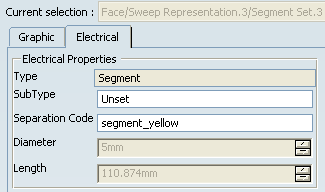About the Compatibility Table | ||
| ||
Separation code compatibility can be determined on a conductor-to-conductor or on a conductor-to-segment basis. Once built, the compatibility table is taken into account via Tools > Options... > Equipment & Systems > Electrical Discipline > Electrical Assembly Design > Conductor Routing: Separation Code File. By default, the compatibility table is not taken into account.
The compatibility table is a text file that describes the separation conditions in the form of a list of compatible separation codes. Each line corresponds to the separation code of one or more conductors:
- In conductor-segment mode:
[Wire separation code] : [Compatible segment separation code]; [Compatible segment separation code]; [etc.];
- In conductor-conductor mode:
[Wire separation code] : [Compatible wire separation code]; [Compatible wire separation code]; [etc.];
Separation codes can be assigned to conductors, conductor groups and segments. This is done via Edit > Properties...
Here is an example of Compatibility Table (for conductor-segment mode):
Wire_Sepcode1 : segment_yellow;segment_brown;segment_violet. wire_Sepcode2 : segment_grey;segment_brown.
If you route a conductor with this separation code wire_Sepcode1, the segment with the segment_yellow separation code can be added to the conductor's routing, but the segment with the segment_grey separation code cannot.
Notes:
- A conductor or conductor group to which no separation code has been assigned can be routed through all harness segments.
- Segments to which no separation code has been assigned accept all conductors or conductor groups.